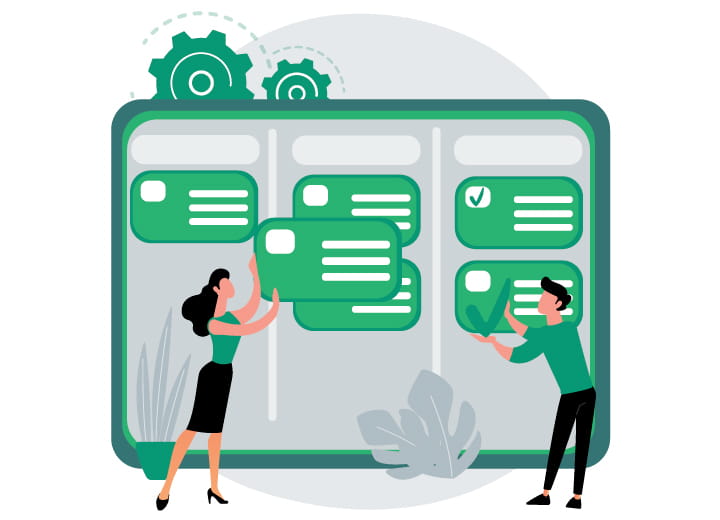Software Development Life Cycle (SDLC) is a systematic approach to delivering high-quality software within a budget and on time. Different types of software development have different purposes, however, they all follow a common life cycle. The life cycle encompasses all parts of a project, from the planning stage, where software requirements are specified, through the maintenance stage, where the software is continuously improved. It is a checklist where a well-structured flow of steps guides the software development process.
Having a solid framework for SDLC is crucial to streamline the overall software development process. This framework acts as a roadmap for the project and helps to identify potential problems early on, reducing the risk of project delays or failures. Additionally, it ensures that all important tasks and milestones are completed, resulting in a high-quality end product that meets both the needs of the client and the vision of the developer.
In this blog, I will provide you with a complete checklist of SDLC to help you manage your software development projects effectively. Whether you are new to software development or an experienced professional, this checklist will help you to stay on track and deliver successful software projects.
Checklist
Anatomy of a Software Development Life Cycle
Planning

The first step in the software development life cycle checklist is the requirement analysis & in-depth planning of the project. In order to deliver a successful software project, there are some critical checkpoints that need to be considered:
✸ Defining the scope of the project
✸ Identifying the project requirements
✸ Considering the purpose, goals, and constraints of the project
✸ Developing a project plan
✸ Allocating resources for the project
✸ Maintaining a timeframe
Outcome: The outcome of this phase is a Software Requirement Specification (SRS) document which includes all the functional and non-functional requirements for the software along with the project goals, product requirements, budget estimations, resource allocation, and deadlines.
This phase basically presents a clear picture of the entire software development project, along with the anticipated roadblocks, opportunities, and directives.
Analysis
In this phase, a feasibility analysis of the project is conducted, including technical, financial, and operational feasibility to determine the software’s viability. The feasibility process undertakes everything that should be designed and developed during the SDLC including:
✸ Gathering information from stakeholders
✸ Performing a feasibility study including budget constraints, legal implications, operational requirements, available in-house skills, and required project timeframe
✸ Identifying potential risks
✸ Developing the existing Software Requirement Specification Document
Outcome: The outcome of this phase is a developed version of the SRS document updated with the outlines of the goals and objectives of the software project after gathering information from stakeholders that serves as a foundation for the subsequent stages of the SDLC.
Design
The design phase of the software development life cycle is where the blueprint for the software is created. This phase involves several key tasks to ensure the software is built to meet the requirements and expectations of the client. The key tasks include:
✸ Creating a system architecture that includes programming languages, databases, interfaces, operating systems, pre-made templates, APIs, etc.
✸ Developing user interface design or UI/UX design
✸ Choosing utilitarian and popular software development tools and technologies
✸ Developing data design which also includes the necessary security measures like SSL encryption, password protection, recommended database migrations, etc.
Outcome: The outcome of this phase is a detailed Design Document Specification (DDS) that consists of all the information developers require to code the product.
The goal of the architectural design phase of an SDLC is to translate client requirements into wireframes so that the end users can offer feedback. This also gives a clear idea to the developers about what they are building.
Implementation

This phase involves the most time-consuming task of the entire software development life cycle which is building and coding the software project. During this phase, the development team gets familiar with the Design Document Specification (DDS) of the project and starts writing code that implements the architectural design of the project. The checkpoints of this phase include:
✸ Writing code
✸ Testing code (basic tests like static code analysis and code reviews for multiple interfaces)
✸ Debugging code
✸ Integrating different components
Outcome: This phase results in fully functional and operational software that meets all the requirements listed in the SRS and DDS.
Testing
In-depth software testing or Quality Assurance (QA) means performing several types of testing to validate the functionality and performance of the software. If the team discovers a defect, the code goes back a step in its life cycle, and developers create a new, flaw-free version of the software. The testing stage ends when the product is stable, free of bugs, and up to quality standards as defined in the previous phases. The importance of QA in software development is huge as it results in the final product being ready to go for production. There are a wide variety of testing methods to evaluate the new product, such as:
✸ Unit testing – to ensure that different individual components or modules of the software work
✸ Integration testing – to ensure that the different individual components or modules of the software work together seamlessly
✸ System testing – to verify whether the software meets the requirements and specifications
✸ Acceptance testing – to validate that the software meets the end user’s needs and expectations.
Outcome: Tested end-product or software ready for production.
Deployment
The goal for the installation & deployment phase is to deploy the software to the production environment for distribution purposes. This phase mainly focuses on making the software available to the users which also involves getting feedback from them. The processes undertaken in this phase include:
✸ Preparing for deployment
✸ Installing and configuring the system
✸ User training
✸ Providing documentation
Outcome: Fully functional and operational end-product or software available to the end users.
Maintenance

Software maintenance and upkeep is an important step in ensuring the continuity and longevity of the software. Software updates are performed regularly to ensure optimal performance. Besides, whenever a user reports a bug or a new feature is added, the product moves back through its SDLC as many steps as required to solve it. Some of the measures being continuously followed as part of product maintenance and enhancement have been listed below:
✸ Monitoring system performance
✸ Providing technical support
✸ Making updates and modifications
✸ Planning for system retirement
Outcome: Fully monitored product or software with continuous updates and enhancement.
The primary focus of software maintenance is to ensure that the software system performs as per the specifications mentioned in the Software Requirement Specification (SRS) from the planning phase. Moreover, continuous monitoring enhances the performance and ensures that there are no major issues, and if there are any, they can be resolved as detected.
Key Takeaways




Software Development Life Cycle (SDLC) is an invaluable tool for software developers, providing them with a complete checklist of the most crucial factors during Software Development. This further enables them to deliver high-quality software solutions in a timely and cost-efficient manner. However, the checklist must be executed in sequential order for the project to be successful. Any skipping, skimming, or half-measures will result in errors that can make the project costly, delayed, and dissatisfying to the client.
Frequently Asked Questions (FAQs)
What is the Software Development Life Cycle (SDLC)?
SDLC is a methodology for delivering software with high quality and within budget and time constraints. It involves a structured flow of stages, from planning and requirement definition to maintenance and enhancement. It is a systematic approach to ensure all aspects of software development are covered.
What is the purpose of gathering requirements in SDLC?
The purpose of requirement gathering in the Software Development Life Cycle (SDLC) is to understand and define the needs, goals, and objectives of the stakeholders in a software project. This process helps to ensure that the final product meets the needs of the users, is aligned with the business goals, and is delivered within the constraints of time and budget.
What is the difference between Waterfall and Agile models in the SDLC?
Waterfall model in SDLC is a sequential, linear approach where each phase must be completed before moving on to the next. The agile model is a flexible, iterative approach where work is completed in short sprints, with continuous feedback and adjustments along the way. Basically, Waterfall Software Development is best suited for projects with well-defined requirements. Whereas, the reason agile software development is gaining popularity, is that it is best for projects with rapidly changing requirements.
How is the SDLC impacted by Agile methodologies?
Agile methodology provides a flexible and adaptive approach to Software Development Life Cycle (SDLC). It helps in reducing risk and increasing collaboration through continuous improvement while delivering high-quality products. By using the Agile model or methodology, teams can respond quickly to changes in project requirements and deliver working software in small increments while keeping the stakeholders engaged in regular feedback loops.
What are the benefits of following a formal SDLC?
A formal Software Development Life Cycle (SDLC) is important because it provides a structured and systematic approach to software development. It ensures that all the necessary steps are taken in a consistent and efficient manner to produce a high-quality software product.


